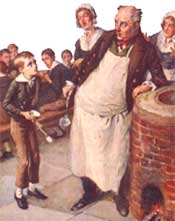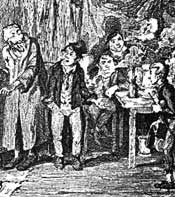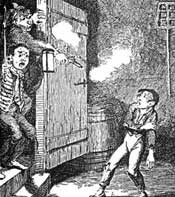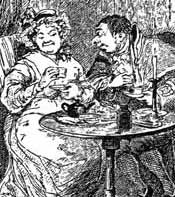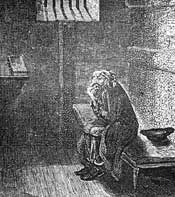The Charles Dickens Page
Charles Dickens'
Oliver Twist
Oliver Twist or, The Parish Boy's Progress
Oliver Twist - Published in monthly parts Feb 1837 - Apr 1839
Illustrations | Locations | Plot | Characters | More | Shop for the Book | Shop for the Video
Charles Dickens' second novel tells the story of the orphan Oliver set against the seamy underside of the London criminal world. Published in monthly parts in Bentley's Miscellany, partly concurrent with Pickwick and Nicholas Nickleby, the novel was illustrated by George Cruikshank.
Dickens did not originally plan to have the story of Oliver to be a novel. The story was begun as a continuation of the Mudfog (based on Chatham, his childhood home) story he wrote for the first edition of Bentley's Miscellany. Michael Slater, in his biography Charles Dickens, relates that by the sixth installment of the story he resolved to make the book the first of two novels he was contracted to write for Richard Bentley and began to introduce details in the story that hinted at future plot complications (Slater, 2009, p. 105).
In this departure from the merry world of Pickwick, Dickens targets the Poor Law Amendment Act of 1834 which renewed the importance of the workhouse as a means of relief for the poor (Ackroyd, 1990, p. 218-219).
Dickens was severely criticized for introducing criminals and prostitutes in Oliver Twist (Schlicke, 1999, p. 433), to which Dickens replied, in the preface to the Library Edition of Oliver Twist in 1858, "I saw no reason, when I wrote this book, why the very dregs of life, so long as their speech did not offend the ear, should not serve the purpose of a moral, at least as well as its froth and cream" (Oliver Twist, p. xv). The novel was well received but not with the adulation of Pickwick.
One of the most dramatized of Charles Dickens' works, Oliver Twist was appearing in 10 theaters in London before serialization of the novel was even completed (Davis, 1999, p. 288). The Internet Movie Database lists nearly 25 film versions, the first in 1906.
Plot
(contains spoilers)
An infant is born of a dying mother in a parish workhouse. Old Sally, attending the birth and death, takes from the dying woman a locket and ring. Bumble, the beadle, names the boy Oliver Twist. Oliver is sent to an infant farm, run by Mrs Mann, until he is 9 years old, at which time he is returned to the workhouse.
The orphans at the workhouse are starving due to callous mistreatment and cast lots to decide who among them will ask for more gruel on behalf of the group and Oliver is chosen. At supper that evening, after the normal allotment, Oliver advances to the master and asks for more.
Oliver is branded a troublemaker and is offered as an apprentice to anyone willing to take him. After narrowly escaping being bound to a chimney sweep, a very dangerous business where small boys are routinely smothered being lowered into chimneys, Oliver is apprenticed to the undertaker, Mr Sowerberry.
Oliver fights with Noah Claypole, another of the undertaker's boys, after Noah mocks Oliver's dead mother. After being unjustly beaten for this offense, Oliver escapes the undertaker's and runs away to London.
On the outskirts on the city Oliver, tired and hungry, meets Jack Dawkins who offers a place to stay in London. Thus Oliver is thrown together with the band of thieves run by the sinister Fagin. Oliver innocently goes "to work" with Dawkins, also known as the Artful Dodger, and Charlie Bates, another of Fagin's boys, and witnesses the real business when Dawkins picks the pocket of a gentleman. When the gentleman, Mr Brownlow, discovers the robbery in progress Oliver is mistaken for the culprit and, after a chase, is captured and taken to the police. Oliver, injured in the chase, is cleared by a witness to the crime and is taken by the kindly Brownlow to his home to recuperate.
Oliver is kindly treated at the Brownlow home and, after a period of recuperation, is sent on an errand by Mr Brownlow to pay a local merchant 5 pounds and to return some books. On carrying out this charge Oliver is captured by Nancy and Bill Sikes and returned to Fagin's den of thieves.
Mr Brownlow, thinking that Oliver has run away with his money concludes that Oliver was a thief all along. This assumption is further strengthened when Bumble the beadle, answering an ad in the paper, placed by Brownlow, for information concerning Oliver, gives a disparaging opinion of Oliver.
Oliver is forced by Fagin to accompany Sikes in an attempted robbery, needing a small boy to enter a window and open the door for the housebreakers. The robbery is foiled when the house is alarmed and, in the ensuing confusion, Oliver is shot.
Oliver is nursed back to health at the home of the Maylies, the house Sikes was attempting to burglarize. Oliver imparts his story to the Maylies and Doctor Losberne.
The mysterious Monks, revealed to be Oliver's half brother, teams up with Fagin in an attempt to recapture Oliver and lead him into a life of crime thereby negating the unknowing Oliver's claim to his rightful inheritance which would then go to Monks.
Sike's woman, Nancy, having compassion for Oliver, overhears Fagin and Monk's plan and tells Rose Maylie in the hope of thwarting the plan. Rose recruits Mr Brownlow, Dr. Losberne, and others.
Bumble the beadle has married the matron of the workhouse, Mrs Corney. The former Mrs Corney, attending the death of Old Sally, has taken the locket and ring that Sally had taken from Oliver's mother on her deathbed. Monks buys this locket and ring from the Bumbles hoping that in destroying it that Oliver's true identity will remain hidden.
Mr Brownlow and Rose Maylie meet Nancy on London Bridge and she tells them where to find Monks. Fagin has had Nancy followed and, enraged, tells Sikes that Nancy has betrayed them. Sikes brutally murders Nancy and flees to the country.
Monks is taken by Mr Brownlow. Fagin is captured and sentenced to be hung. Sikes, with a mob on his tail, accidentally hangs himself trying to escape. The Bumbles are relieved of their position at the workhouse, become paupers, and are now inmates at the same workhouse they once managed.
Oliver is revealed to be the illegitimate son of Edwin Leeford and Agnes Fleming. Leeford has fathered the evil Edward (Monks) through a failed former marriage. After seducing Agnes, Edwin dies, leaving a will which states that the unborn child will inherit his estate if "in his minority he should never have stained his name with any public act of dishonor, meanness, cowardice, or wrong" in the event of which all would go to Edward (Monks), hence Monk's attempt to corrupt Oliver via Fagin.
Monks is given half of Oliver's inheritance by Mr Brownlow, who had been a friend of Edwin Leeford, in the hope that he will start a new life. Monks flees to America where he quickly squanders his portion and dies in prison. Rose Maylie is revealed to be the sister of Agnes Fleming who is adopted by the Maylies after her parents die, therefore Rose is Oliver's aunt.
Oliver collects his inheritance and is adopted by Mr Brownlow. Rose marries longtime beau, Harry Maylie.

Complete List of Characters:
Character descriptions contain spoilers
Oliver Twist Links:
Bartleby.com
SparkNotes - Excellent!
Oliver Twist: etext from University of Virginia Library
Searchable Oliver Twist - The Literature Network
Oliver Twist: Barron's BookNotes
Wikipedia - Oliver Twist
From Fagin to Riah: How Charles Dickens looked at the Jews - Herb Moskovitz
Oliver Twist
Further Information
The Anatomy Act of 1832
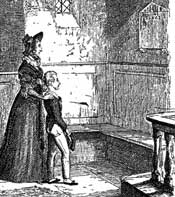
The empty tomb
Before 1832 only the bodies of murderers could legally be used for dissection by medical students. This caused a brisk business for body-snatchers to supply the demand.
With the passage of the Anatomy Act unclaimed bodies from prisons and workhouses would be donated for this cause. The terrifying thought of having your body dissected after death became yet another powerful deterrent to entering the workhouse system.
Charles Dickens alludes to the recently enacted Anatomy Act when he has Oliver's mother's body disappear. Ruth Richardson, in her book Dickens and the Workhouse, says "It is part of the subtext of the novel that the poor young woman who dies in its opening pages was being dissected while her son was being starved" (Richardson, 2012, p. 236).
Indeed, at the end of the novel as Oliver and Rose stand at the tomb of Agnes Dickens says in the text "Within the alter of the old village church there stands a white marble tablet, which bears as yet but one word: AGNES. There is no coffin in that tomb..." (Oliver Twist, p. 415)
Oliver Twist Maps:
Fagin the Jew
Anti-Semitism, ingrained into English society at the time Oliver Twist was written (1837), manifest itself in Charles Dickens' depiction of Fagin. Dickens expressed surprise when the Jewish community complained about the stereotypical depiction of Fagin. Later, when Dickens sold his London residence, Tavistock House, to a Jewish couple, whom he befriended, he was compelled to make restitution. In his novel, Our Mutual Friend, Dickens created Riah, a positive Jewish character. Dickens also, when editing Oliver Twist for the Charles Dickens edition of his works, eliminated most references to Fagin as "the Jew" (Slater, 2009, p. 516-517).
Dickens expressed surprise when the Jewish community complained about the stereotypical depiction of Fagin. Later, when Dickens sold his London residence, Tavistock House, to a Jewish couple, whom he befriended, he was compelled to make restitution. In his novel, Our Mutual Friend, Dickens created Riah, a positive Jewish character. Dickens also, when editing Oliver Twist for the Charles Dickens edition of his works, eliminated most references to Fagin as "the Jew" (Slater, 2009, p. 516-517).
The Bow Street Runners
 Blathers and Duff, who responded to the attempted robbery of the Maylie home, were officers in the famous Bow Street Runners. This group operated as London's police force from 1750 until they were incorporated into Sir Robert Peel's Metropolitan Police in 1829.
Blathers and Duff, who responded to the attempted robbery of the Maylie home, were officers in the famous Bow Street Runners. This group operated as London's police force from 1750 until they were incorporated into Sir Robert Peel's Metropolitan Police in 1829.
The Bow Street Runners earned their income through rewards and private fees and gained much of their information through the use of informers. Because they were mobile and traveled all over England, they were much more effective at catching criminals than the stationary London Watch (Wikipedia).
The Law is a Ass
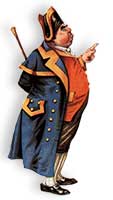 When Mr Bumble tries to pass the guilt of the stolen locket and ring off on his wife, Mr Brownlow informs him that in the eyes of the law Bumble was the more guilty of the two because the law assumes that his wife operated under his direction.
When Mr Bumble tries to pass the guilt of the stolen locket and ring off on his wife, Mr Brownlow informs him that in the eyes of the law Bumble was the more guilty of the two because the law assumes that his wife operated under his direction.
Bumble's reply, one of the most quoted lines in all of Dickens, implies that any married man knows that he has no such control over the actions of his wife.
"If the law supposes that" said Mr. Bumble, squeezing his hat emphatically in both hands, "the law is a ass - a idiot. If that's the eye of the law, the law is a bachelor; and the worst I wish the law is, that his eye may be opened by experience-by experience" (Oliver Twist, p. 399).
In the opening chapters of Oliver Twist Charles Dickens attacks the New Poor Law, enacted in 1834. Previously it had been the burden of the parishes to care for the poor through alms and taxes, the needy could go to the parish workhouse or apply for 'outdoor relief', which enabled them to live at home and work outside jobs. The new law banded parishes together into unions, each union had a workhouse, and all those seeking relief were required to become inmates in the workhouse. The new law made seeking relief as undesirable as possible (The National Archives).
The workhouse was little more than a prison for the poor. Civil liberties were denied, families were separated, and human dignity was destroyed. The meager diet instituted in the workhouse prompted Dickens to quip that the poor were offered the choice of "being starved by a gradual process in the house, or by a quick one out of it" (Oliver Twist, p. 11).
Chimney Sweep Apprentices
Oliver is justified in being terrified to be apprenticed to Mr Gamfield the chimney sweep. Small boys were sought out by sweeps because they were small enough to be lowered into chimneys to brush away the soot. Such boys were called apprentices but in actuality had oftentimes been sold into slavery by their impoverished parents. Also, as in Oliver's case, children of the workhouses were apprenticed in order to keep down costs to the parish.
Sweeps felt that the optimum age for an apprentice was 6 years of age but boys as young as 4 were used. Tales of boys getting stuck in the flues and suffocating or burning to death were common. The practice was finally abolished in 1875 (Ackroyd, 2000, p. 637-638).
Oliver Asks for More
Child as he was, he was desperate with hunger, and reckless with misery. He rose from the table; and advancing to the master, basin and spoon in hand, said: somewhat alarmed at his own temerity:
'Please, sir, I want some more.'
The master was a fat, healthy man; but he turned very pale. He gazed in stupified astonishment on the small rebel for some seconds, and then clung for support to the copper. The assistants were paralysed with wonder; the boys with fear. More...
Charles Dickens' life during the serialization of Oliver Twist
Feb 1837 - Apr 1839Dickens' age: 25-27
February 1837
March 1837
Moves from chambers at Furnival's Inn to a house at 48 Doughty Street (Johnson, 1952, p. 191-192).
May 1837
Catherine's sister Mary Hogarth dies (Ackroyd, 1990, p. 225).
June 1837
Grieving for his beloved sister-in-law Dickens misses deadlines for the only time in his life. Monthly issues of Pickwick Papers and Oliver Twist are not published (Ackroyd, 1990, p. 228).
October 1837
Finishes serialization of Pickwick Papers (Slater, 2009, p. 109).
January 1838
Dickens and Hablot Browne leave for Yorkshire to do research for Nicholas Nickleby (Ackroyd, 1990, p. 250).
March 1838
Serialization of Nicholas Nickleby begins (Schlicke, 1999, p. 404).
Daughter Mary (Mamie) Dickens born (Ackroyd, 1990, p. 270).
November 1838
Oliver Twist published in 3 volumes. Dickens revised the monthly parts for the publication which was the first published under Charles Dickens instead of Boz. Monthly serialization in Bentley's Miscellany continues (Schlicke, 1999, p. 429).
April 1839
Oliver Twist: Flash Language
Confused by some of the terms used by The Artful Dodger and others in Fagin's gang of thieves? The slang they use within the group was termed Flash Language by a former British convict, James Hardy Vaux, who compiled a list of such terms in his Vocabulary of the Flash Language written in 1812.
Dickens and Cruikshank

The illustrations for Oliver Twist by George Cruikshank (1792-1878) are thought by many to be some of the finest for any Charles Dickens novel. Fagin in the Condemned Cell is a particularly effective illustration, conveying the feeling of isolation and anxiety of Fagin's last hours (Patten, 1992, p. 122).
Cruikshank had formerly provided illustrations for Dickens' Sketches by Boz but after Oliver Twist never illustrated another Dickens work. Author and artist remained friends through the 1840s until Cruikshank, formerly a heavy imbiber, became a zealous supporter of temperance. Dickens, in favor of moderation, took exception to Cruikshank's fanatical ravings on temperance and the friendship deteriorated (Patten, 1992, p. 228-229).
In 1872, two years after Dickens' death, Cruikshank claimed that the plot and many of the characters from Oliver Twist had been his idea, a claim which Dickens' friend and biographer, John Forster, vehemently denied (Forster, 1899, v. 2, p. 31-32).
The debate about how much influence Cruikshank had on the publication of Oliver Twist continues to this day (Vogler, Cruikshank and Dickens: A Reassessment of the Role of the Artist and the Author, George Cruikshank, Robert L. Patten, 1992, p. 61-91).
The Death of Nancy
 In 1868, with his health rapidly declining, Charles Dickens began a farewell reading tour of Britain.
In 1868, with his health rapidly declining, Charles Dickens began a farewell reading tour of Britain.
For this tour Dickens added a very passionate and dramatic performance of the murder of Nancy from Oliver Twist, despite pleas from his family and friends not to include it, fearing for his health (Davis, 1999, p. 353).
Many believe that the energy expended in these performances, which he read with such passion and violence that woman fainted in the aisles, hastened his early death in June, 1870 (Ackroyd, 1990, p. 1062-1063).
The Artful Dodger
".He was a snub-nosed, flat-browed, commonfaced boy enough; and as dirty a juvenile as one would wish to see; but he had about him all the airs and manners of a man.  He was short for his age; with rather bow-legs, and little, sharp, ugly eyes. His hat was stuck on the top of his head so lightly, that it threatened to fall off every moment and would have done so, very often, if the wearer had not had a knack of every now and then, giving his head a sudden twitch, which brought it back to its old place again. He wore a man's coat, which reached nearly to his heels. He had turned the cuffs back, half-way up his arm, to get his hands out of the sleeves, apparently with the ultimate view of thrusting them into the pockets of his corduroy trousers; for there he kept them. He was, altogether, as roystering and swaggering a young gentleman as ever stood four feet six, or something less, in his bluchers" (Oliver Twist, p. 53).
He was short for his age; with rather bow-legs, and little, sharp, ugly eyes. His hat was stuck on the top of his head so lightly, that it threatened to fall off every moment and would have done so, very often, if the wearer had not had a knack of every now and then, giving his head a sudden twitch, which brought it back to its old place again. He wore a man's coat, which reached nearly to his heels. He had turned the cuffs back, half-way up his arm, to get his hands out of the sleeves, apparently with the ultimate view of thrusting them into the pockets of his corduroy trousers; for there he kept them. He was, altogether, as roystering and swaggering a young gentleman as ever stood four feet six, or something less, in his bluchers" (Oliver Twist, p. 53).
Oliver Twist and the London Poor
Dr. Ruth Richardson's wonderful exploration of Dickens' childhood home on Norfolk Street, London and the influence of the workhouse located nearby.
